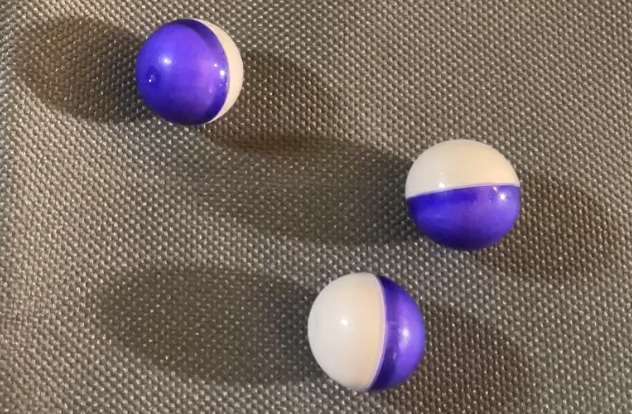
First, let’s discuss the basics (generally regarded as a good place to begin).
The Pepperball Patrol Carbine, or PPC, is a roughly AR-15 sized and styled platform that’s used to launch Pepperballs. What’s a Pepperball, you ask?

These, dearest reader, are Pepperballs. Inert ones, in this case, but aside from the scrumptious filling and some colors, they’re identical to the real thing. If you’ve ever paid attention to paintball markers, you’ll notice a remarkable resemblance, and with good reason. They’re 0.68 caliber spheres that are filled with a payload.
In the case of the inert projectiles, they’re a touch firmer than a paintball and rather than being filled with marking paint, they’re filled with what’s basically baby powder. These are generally used for training purposes to allow the user to practice the mechanics of the Pepperball launcher without the effects of the “Live-X” regular projectiles are filled with.
Live-X is the name for the live cartridges that contain PAVA powder:

For the curious, PAVA is pelargonic acid vanillylamide – an oft-manufactured capsaicin analogue, found naturally in chili peppers, usually used in seasonings and other cooking methods. Which is to say in layman’s terms, it’s spicy.
Live-X is 5% PAVA, Live SD is 2%, and the law enforcement only Live-MAXX is 5% proprietary “Maxsaicinpava” powder, which is advertised to have 50% more bio-availability (how easy, or not, it is for the human body to take in and recognize/”use”) than standard PAVA.
For context, most “pepper spray” devices contain anywhere from 0.18-3% of a “major capsaicinoid count” (MCC) – my personal favorite for “average Joe” use is of course POM Pepper Spray – compared to the Pepperball products, POM has 1.4% MCC.
It’s not a perfect 1:1 comparison between MCC and PAVA, but it helps give some context as to why 2% or 5% PAVA can be much more effective than one might initially expect.
Another interesting benefit to the way the Pepperball devices function is that they’re one of the only truly non-lethal options available on the market. As contrasted with tools like 40mm launchers and even TASER devices, which are considered “less than lethal” (meaning they still have the potential to cause great bodily harm or death), the Pepperball launchers are virtually incapable* of causing death or great bodily harm.
*I am not a lawyer and this is not legal advice, nor is it official guidance from the manufacturer
One other unique feature of Pepperball is its ability to perform area saturation/area denial activities – by hitting a stationary object with the projectiles, the user can deploy the powder over an area and make it at a minimum uncomfortable for a subject to enter or remain in that area. Even after the dust has settled, the powder is very easily disturbed by walking and other activity in the area… something that I’ve had a bit of experience with at the range a day or so after the Pepperball training happens. Let’s just say muzzle blast definitely stirs it up enough to be noticeable.
All that to say, particularly for law enforcement, the Pepperball devices offer some unique advantages over other options available today. I am personally very much a booster for their offerings for professional use, which for the record is the only available avenue to acquire or use the PPC launcher.
They do offer some consumer-grade launchers, but I have not had the opportunity to use any of them as of this writing.
I’ve done one video of the launcher so far, just breaking down the device and its features, which you can find here:
I’m about to do a video where I actually fire and use the PPC, so if you have any suggestions hop over to YouTube, Instagram or Facebook and leave a comment or send me a message!
Stay safe.